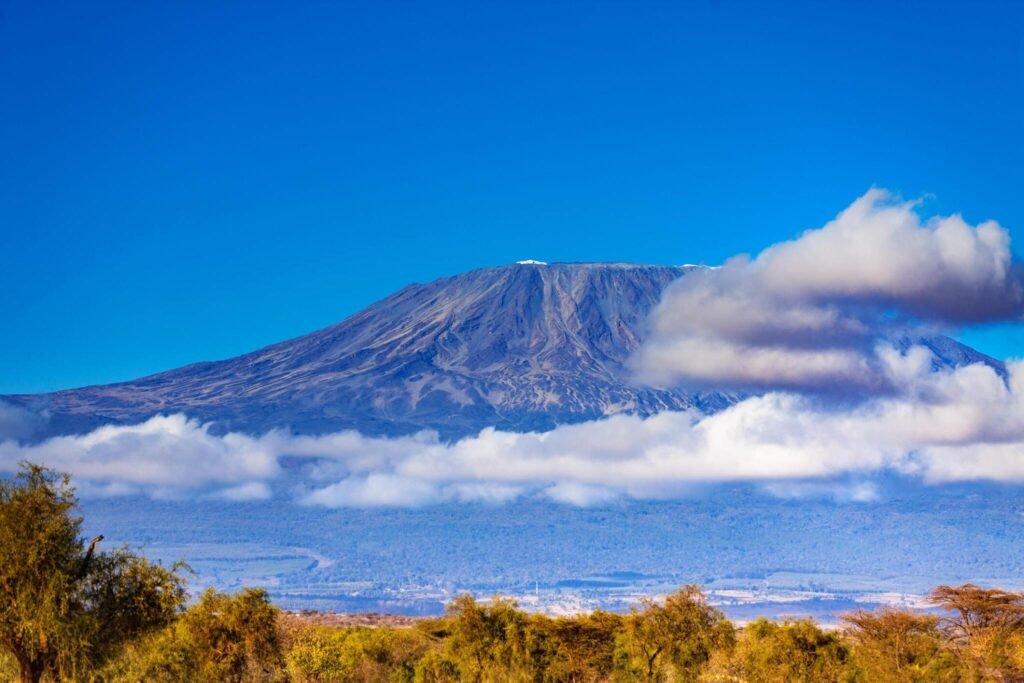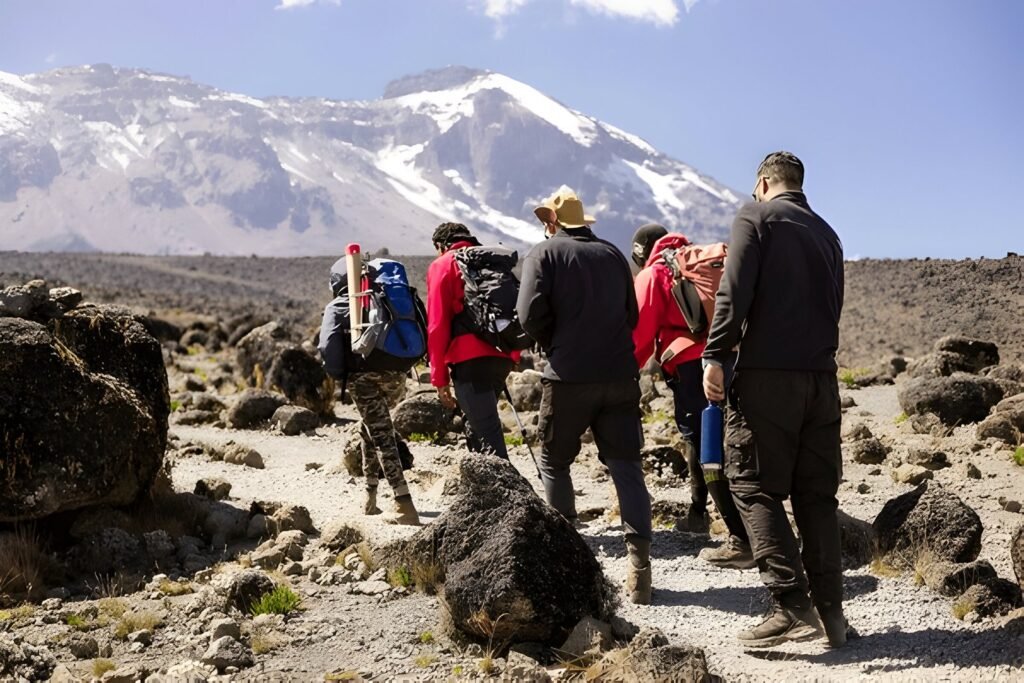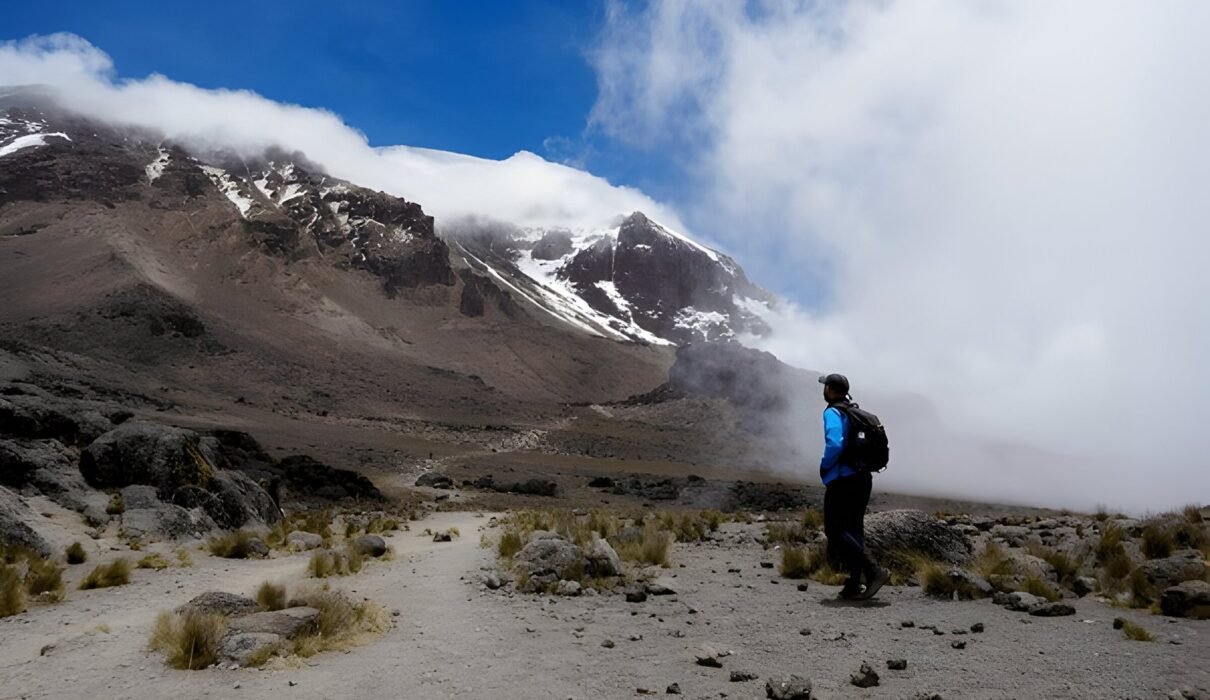A Typical Day on Kilimanjaro-What to Expect : Climbing Mount Kilimanjaro is a life-changing adventure, but knowing what to expect each day can help you prepare mentally and physically for the challenge ahead. Each day on the mountain brings different experiences, from early morning starts to reaching higher altitudes. This guide will take you through a typical day on Kilimanjaro, from morning routines to evening camp life, so you can plan your journey with confidence.

A Typical Day on Kilimanjaro-What to Expect : Morning on Kilimanjaro: Waking Up Above the Clouds
A day on Kilimanjaro usually begins early, often between 5:30 and 6:00 AM. As the sun rises, you’ll be greeted with breathtaking views of the surrounding landscapes, including cloud-covered valleys and distant mountain ranges. Your guides will bring warm tea or coffee to your tent, giving you a chance to start the day with a hot drink while soaking in the view.
Breakfast is typically served around 7:00 AM and includes high-energy foods like porridge, eggs, toast, and fruit. It’s important to eat well in the morning, as the day ahead will require plenty of energy.
Learn more about the best breakfast foods for climbers.
Packing and Preparing for the Day’s Hike
After breakfast, you’ll prepare your daypack, making sure you have essential items such as water, snacks, a rain jacket, and sunscreen. Your porters will carry the bulk of your gear, so your daypack should only contain what you need for the day’s hike.
Most days on Kilimanjaro involve several hours of hiking, with varying terrains and altitudes. You’ll be trekking through different climate zones, from rainforests to alpine deserts, so dressing in layers is essential. Morning temperatures can be chilly, but as the sun rises, it warms up quickly.
Find out how to layer properly for outdoor activities.
The Morning Trek: Steady and Slow
Trekking begins around 8:00 AM, and the key to success on Kilimanjaro is maintaining a slow, steady pace. This is often referred to as the “Pole Pole” (slowly, slowly) approach, which helps your body adjust to the altitude and prevents exhaustion. Your guides will remind you to drink plenty of water to stay hydrated, especially as the air becomes drier at higher elevations.
The morning hike lasts about 3-4 hours, with regular breaks for water and snacks. You’ll have the chance to enjoy the scenery, spot wildlife, and take photos along the way.
Read more about the benefits of hiking at a slow pace.
Lunchtime: Refuel for the Afternoon Hike:A Typical Day on Kilimanjaro-What to Expect
By midday, you’ll stop for lunch at a scenic spot along the trail. Meals on Kilimanjaro are prepared by the camp chefs and are designed to be nutritious and easy to digest. A typical lunch might include soup, sandwiches, pasta, and fresh fruit. This meal provides the fuel you need to continue hiking for the rest of the day.
After lunch, you’ll have a short rest before setting off for the afternoon leg of the trek.
Learn more about meal planning for high-altitude treks.
The Afternoon Hike: Reaching Higher Altitudes :- A Typical Day on Kilimanjaro-What to Expect
The afternoon hike typically involves ascending to a higher camp, with trekking times varying depending on the day’s itinerary. You might hike for another 2-4 hours, depending on the distance between camps. As you climb higher, you’ll notice the landscape changing from lush vegetation to rocky, barren terrain.
The air becomes thinner at higher altitudes, so it’s important to go at your own pace and follow your guide’s instructions. You may begin to feel the effects of altitude, such as mild headaches or shortness of breath, which is normal. Your guide will monitor your condition and ensure you stay safe.
Learn how to acclimatize during high-altitude climbs.
Arriving at Camp: Rest and Recovery : A Typical Day on Kilimanjaro-What to Expect
You’ll arrive at your next camp by mid to late afternoon, where your tent and gear will already be set up by the porters. This is a time to rest, relax, and recover from the day’s hike. You can change into warm, comfortable clothing, wash up, and enjoy some tea or snacks while chatting with fellow climbers.
Camp life on Kilimanjaro is simple but comfortable. Most camps are equipped with dining tents where you’ll have dinner with your group. Meals are hearty and include a mix of carbs, protein, and vegetables to help you replenish your energy. Typical dinners include rice or pasta dishes, meat stews, and fresh vegetables.
Explore more about staying comfortable at high-altitude camps.
Evening Routine: Preparing for the Next Day : A Typical Day on Kilimanjaro-What to Expect
Evenings on Kilimanjaro are quiet and relaxing. After dinner, your guide will give a briefing about the next day’s trek, including what to expect in terms of terrain, weather, and altitude gain. This is a great time to ask questions and get any additional advice you need.
As night falls, temperatures can drop significantly, especially at higher camps. You’ll want to dress warmly and make sure your sleeping bag is rated for cold weather. Most trekkers head to bed early, usually by 8:00 or 9:00 PM, to get plenty of rest before another long day of hiking.
Learn about proper sleeping gear for cold weather camping.
The Summit Night: The Final Push to Uhuru Peak : A Typical Day on Kilimanjaro-What to Expect
The most challenging day of the trek is summit night, which typically begins at midnight. You’ll wake up around 11:00 PM and have a light meal before setting off for the final ascent. The goal is to reach Uhuru Peak at sunrise, which is an awe-inspiring moment after hours of trekking through the dark.
The climb to the summit is steep and physically demanding, with cold temperatures and high altitude making it even tougher. However, reaching the top and witnessing the sunrise over Africa is a reward like no other.
For expert guidance on your Kilimanjaro trek, consider booking with Kilimanjaro Climb Specialist, who offer personalized and safe trekking experiences.
A Typical Day on Kilimanjaro-What to Expect : Planning Your Kilimanjaro Adventure
A successful Kilimanjaro trek depends on preparation, both mentally and physically. Knowing what to expect each day helps you feel more confident and ensures that you make the most of your journey. Whether you’re hiking through lush rainforests, crossing alpine deserts, or making the final push to the summit, each day on Kilimanjaro brings its own challenges and rewards.
For a seamless trekking experience with experienced guides, check out Kilimanjaro Climb Specialist or combine your climb with a safari package from Eddy Tours & Safaris.

Conclusion: Every Day on Kilimanjaro is a New Adventure
A typical day on Kilimanjaro is a mix of excitement, challenge, and awe. From the early morning sunrises to the quiet evenings at camp, each day brings you closer to reaching the summit of Africa’s highest mountain. By understanding the daily routine, you’ll be better prepared to enjoy the journey and conquer the challenge.
Ready to take on Kilimanjaro? Plan your trek with Kilimanjaro Climb Specialist or Eddy Tours & Safaris for a well-organized adventure.

